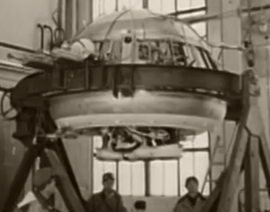Block E (rocket)
 | |
|---|---|
 | |
| Description | |
| Role | Propulsion Unit |
| Engines | RD-858 and RD-859 |
| Height | 1720 mm |
| Diameter | 2380 mm |
| Empty Mass | 525 kg |
| Fueled Mass | 2,950 kg |
Block E is the propulsion unit of Soviet lunar module LK, developed in 1960s by Yuzhnoye Design Bureau as a part of the manned lunar landing program. Block E was designed to soft land LK on the surface of the Moon after orbital velocity was cancelled by Block D and later to launch LK to the Moon orbit for the rendezvous with Soyuz 7K-LOK.[1][2]
Block E used RD-858, which has one nozzle and is deeply throttleable (from 2050 kg to 858 kg of thrust),[3] as the primary engine. The backup engine was RD-859, which has two nozzles. Engines were equipped with clam-shell doors to prevent damaging it while staying on the surface of the Moon. There were four additional vernier engines placed between main and backup engine nozzles.
References
- ↑ "LK spacecraft and Block E". Russianspaceweb.com. Archived from the original on 2013-12-30. Retrieved 2013-12-15.
- ↑ "Liquid propellant propulsion systems, Yuzhnoe Design Bureau". yuzhnoe.com. Retrieved 2014-07-10.
- ↑ "RD-858". Astronautix.com. Retrieved 2016-03-18.
This article is issued from
Wikipedia.
The text is licensed under Creative Commons - Attribution - Sharealike.
Additional terms may apply for the media files.


